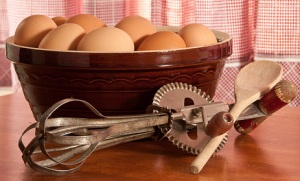
Hand-operated rotary egg beaters were invented just before 1860, but at that time it wasn’t yet clear what the best design for the job would be. Different inventors had different ideas for labour-saving ways of whisking eggs. The first beaters with rotating parts were probably an American design patented in 1856 (below right) and, in England, Griffiths’ Whisk patented 1857 (below left). A very different “egg-beater” invented in 1849 is illustrated near the bottom of the page.
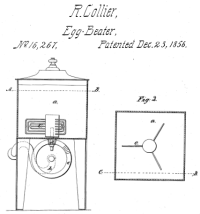
Rotating beaters with a handle were always going to work best, but they came in different forms. Some early ones were fixed inside a pot, and couldn’t be used with the cook’s own choice of mixing bowl. Some were developed by the same inventors who designed small hand-cranked butter churns.

By the 1880s, mechanical egg beaters were usually the shape we know now. In the US they were called Dover egg beaters after being popularised by the Dover Stamping Company. The company acquired patents from a series of inventors, starting with the Monroe egg beater (below right), patented in the US in 1859. This design got a UK patent soon after and was manufactured in London by George Kent who also marketed the Griffiths model.
Some inventors focused on whipping egg whites and emphasised how much air they could get into the mix. Others wrote about batter and other mixtures as well as eggs.
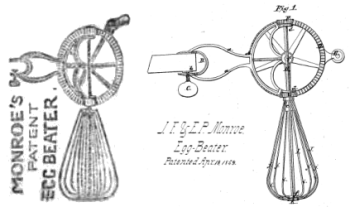
Eggs prepared by beating are thoroughly charged with atmospheric air… (Collier patent, 1856)
Who used the new egg beaters?
The 1856 patent, like others after it, said how useful the new invention would be for hotels and restaurants as well as for ordinary households hoping to speed up a “laborious and fatiguing operation”. But some people may have been influenced against the new egg beaters by cookery experts who didn’t think highly of new-fangled devices.
…beat…with the proper stroke, and with wooden rods, and in a shallow, flat-bottomed earthen[ware] pan. The coldness of a tin pan retards the lightness of the eggs. For the same reason do not use a metal egg-beater…..put…the egg-beater always down to the bottom of the pan…Continue till the surface is smooth as a mirror, and the beaten egg as thick as a rich boiled custard… (Eliza Leslie, The Lady’s Receipt-Book, 1847)*

However, by the 1890s The “Dover” egg beater was well-established in the US and was often mentioned in recipes and ads. In the 20 years between 1870 and 1890 Dover made 4 million egg beaters. Almost all were “family size” but they also sold 1000 “hotel size” and 10,000 “extra family size”.**
There’s less evidence of rotary beaters getting a firm grip in Victorian Britain, although some people certainly used them. With no well-known brand like Dover, they were advertised as “one-minute” or “ten-second” beaters, or with fanciful names like Biatrope or Archimedian. Advice on cooking and equipping kitchens mostly assumed an ordinary wire whisk would be just fine. Rotary hand mixers seem to have been even less popular in continental Europe.
To clamp or not to clamp?
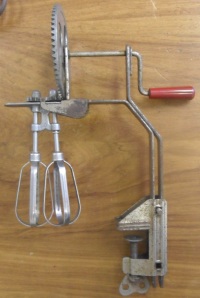
Holding the beater by screwing it onto something fixed seems like a good idea, rather like an electric mixer set firm on a stand. The Monroes’ clamp was part of the original design, but you do wonder how it would work in an ordinary kitchen. Was the bowl held below a table? In 1859 a UK business demonstrated an “egg whisk, fitted with arrangement for screwing to table”.
The later 1800s saw numerous US patents for original clamping devices, presumably trying to improve on what we may call a “normal” clamp. But how many people really used egg beaters like this? Not many have survived. Most antique egg beaters are clamp-free.
Perhaps a hand egg beater is more versatile without a screw fitting? Perhaps the clamp has to be solid and strong to be effective? But then it would be more nuisance for washing and storing. The advertising I’ve seen doesn’t mention clamps.
EGG-BEATER: We have tried five different kinds in Boston, before a large audience and on the demand of an inventor of one, but none could beat eggs as well as a common hand-beater. The whites of the eggs could not be raised with any of the others much more than half as much as with the common one; and besides, could not be beaten stiff……Any tinsmith can make an egg-beater. It is generally made with tin-wire, but may be made with brass-wire.
1867, Handbook of Practical Cookery, Pierre Blot
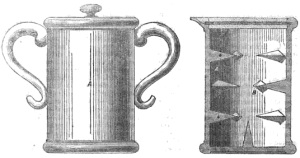
Notes
*Eliza Leslie’s advice was often quoted from the 1850s to 1870s
**Massachusetts reports: cases argued and determined in the Supreme Judicial Court of Massachusetts, Jan – June 1895
Photos
Photographers credited in captions. Special thanks to Ema Marx of the Dias Museum for photos and correspondence. Thanks also to photoptimist for the first picture and Elizabeth Thomsen for the Dover beater photo.
More picture info here
I have an orginall kents Improved Egg beater which was given to me 20years ago,It is with great intrest that i read your article.
LikeLike
I am looking for the history of the Maynard co., who made hand beaters in the 1950’s. I want to know about the company and what other products the made.
LikeLike
I just discovered that the Maynard Manufacturing Company was based in Glendale CA. Its 1950 Master Mixer was based on a 1923 design. That design uses hard nylon plastic on the dashers to minimize splashing. They also made Ice Cream Scoops, as I have one of those.
LikeLike
Hello:
I too, am interested in the Maynard egg beaters. When I find them, I offer them to my husband’s daughters as their paternal great grandmother was a Maynard. It hasn’t been easy tracking any info down on this company. Have you learned more information since 2012? I research family history and just wondered if there was a connection.
Thank you.
LikeLike
Mark Maynard, inventor of this item, was my great Uncle and came out of the Washington/Idaho area. My mother used to talk about how kind he was to her as a child, when she and her mother, Nellie Maynard, visited him in the Salmon River Breaks. I was privileged to meet him when I was about 20, and very pleased to perceive that his kindness was still a genuine and lovely part of him.
LikeLike
Doing research on the Maynard family, I had a chance to speak to a 3rd cousin today who told me about the Maynard Egg Beater. My understanding is that Mark Maynard, the inventor, was a son of Charles Maynard. Charles was the youngest brother of my great-grandfather John Wesley Maynard. It appears that at least L.Gray and Molly McCune — and possibly Scott Maynard — who have posted above are also related to this Maynard clan. If so, I would love to connect with you — as well as anyone else related to my great-great grandparents Nathan and Elizabeth Maynard! Please contact me at maynnews@icloud.com . Thanks, Steve
LikeLike
I just purchased a rotary hand beater with an emblem resembling a shield with a strike through it . I found one similar but with an aqua handle instead of the brass or copper one I purchased. The one I found on line said EAMES. Do you have any idea what that means?
LikeLike
Hi there, I have come across a Josiah Lorkin iron stone egg beater pictured above.and its in excellent condition. Would this beautiful strange beater be worth much ? I have listed it on ebay,Best regards Paul
LikeLike
I have a book on all old beaters Dover Beaters and other brand manufactured between 1829 and 1880 price guide and later years. Book Tittle and Author (300 Year of Kitchen Collectibles ) by Linda Campbell Franklin. I believe the large soft cover book is still available. There were many different ages of the Egg Beaters which I want to share prices with based on 1991 appraisals.
Oldest to Newest;
Dover Beaters Patent 1829 – 1880 ($165-$200) Pending shape
Paine, Diehl & Co Patent c. 1885-1895 ($125.00-$200) Pending Shape
French Early Zig Zag LeTourbillion Pat no 1,992,564, ‘1934’ French early 20 century ($150.00-$250.00) pending shape.
Eggbeaters & Cream Whips, MP Hougen , Whippit Cream & Egg Beater, Duro Metal Product Co. Chicago Pat no, 1,705,639 White & Teal blue marbled wood handle, upright scraper years ‘1906-1916 ( $75.00- $100) Pending Shape
LikeLike
Do you have anything on the Hutchinson Company? I am looking for pat. Sept. 2, 1913.
It has a built in beater in top that fits on a bowl. All metal. Thank you. Judy Jones
LikeLike
My mom always made whipped cream in a metal bowl with an egg beater top that fit on the bowl. It was made by ” Hutchinson ”
” S No2 S ”
&
” New York ”
” Pat. Sept. 2, 1913 ”
I still have it and it still works. Does anyone have any history on this company? Product?
LikeLike
I’m so happy to read this. This is the kind of manual that
needs to be given and not the random misinformation that’s at the other
blogs. Appreciate your sharing this best doc.
LikeLike
Good info. Lucky me I discovered your blog by chance (stumbleupon).
I hafe bookmarked it for later!
LikeLike
An outstanding share! I have just forwarded this onto a co-worker who has been conducting a little homework on this.
And he actually bought me breakfast simply because I stumbled upon it for him…
lol. So let me reword this…. Thank YOU for the meal!!
But yeah, thanx for spending the time to talk about this issue here on your website.
LikeLike
Hello, I am interested in some information relating to a antique egg beater, I have found very similar in design online however not the exact one, this one has the has the name “AIDEX” inscribed in it and also says “MADE IN ENGLAND” and “PAT. APPLIED FOR”. There is absolutely nothing relating to “AIDEX” online that I can find? Any information would be appreciated. Many thanks.
LikeLike
You are so cool! I do not suppose I’ve truly read through a single thing like that before. So good to find another person with a few original thoughts on this subject matter. Really.. thank you for starting this up. This web site is one thing that’s needed on the web, someone with some originality!
LikeLike
Hi there every one, here every one is sharing these know-how, therefore it’s good to read this weblog, and I used to pay a visit this blog all the time.
LikeLike
I absolutely love your blog and find almost all of your post’s to be precisely what I’m looking for. Does one offer guest writers to write content available for you? I wouldn’t mind writing a post or elaborating on some of the subjects you write about here. Again, awesome website!
LikeLike
I have just acquired the clamping beater shown in the picture above from the Dias Museum. Would love to find more information on it. Thanks
LikeLike
Thanks so much for your very enlightening article. I found Wikipedia almost useless on this topic. I grew up in New Zealand, where we did not have a rotary egg beater until the late 1950s. I have several mid-20th century Australian cookbooks which treat the rotary beater as a new and exciting innovation!
LikeLike
I often visit your website and have noticed that you don’t update it often. More frequent
updates will give your website higher authority & rank in google.
I know that writing articles takes a lot of time, but you can always help yourself with miftolo’s tools which will shorten the time of
creating an article to a few seconds.
LikeLike
Thanks for sharing. I learned a lot about egg beaters from your post. Keep sharing
LikeLike
I have this egg whisk, but there is no clamp, but an iron base.
Do you know anything about this? I have not been able to find any pictures on the Internet.
I have tried to send a picture, but I have been unable to.
Kind regards Ulla Jessen.
LikeLike